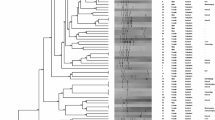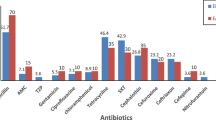Abstract
Occurrence ofcnf1+ E. coli pathogenic strains among extraintestinalE. coli isolates was evaluated to explain an impact of cytotoxic necrotizing factor type 1 (CNF1) in human infections. A total of 120E. coli isolates were characterized for presence of virulence factorscnf1- andpap- specific sequences by PCR, and the production of α-hemolysin using blood agar-plate test. Different association patterns among the detected virulence factors were obtained by comparison of various groups of clinicalE. coli isolates. These differences probably reflect a potential impact of CNF1 in the colonization of vaginal environment.
Similar content being viewed by others
References
Aktories K.: Rho proteins: targets for bacterial toxins.Trends Microbiol.5, 282–288 (1997).
Andreu A., Stapleton A.E., Fennel C., Lockman H.A., Xercavins M., Fernandez F., Stamm W.E.: Urovirulence determinants inEscherichia coli strains causing prostatitis.J. Infect. Dis.176, 464–469 (1997).
Blanco M., Blanco J.E., Blanco J., Alonso M.P., Balsalbore C., Mourino M., Madrid C., Juárez A.: Polymerase chain reaction for detection ofEscherichia coli strains producing cytotoxic necrotizing factor type 1 and type 2 (CNF1 and CNF2).J. Microbiol. Meth.26, 95–100 (1996a).
Blanco M., Blanco J.E., Alonso M.P., Blanco J.: Virulence factors and O groups ofEscherichia coli isolates from patients with acute pyelonephritis, cystitis and asymptomatic bacteriuria.Eur. J. Epidemiol.12, 191–198 (1996b).
Blanco M., Blanco J.E., Rodríguez E., Abalia I., Alonso M.P., Blanco J.: Detection of virulence genes in uropathogenicEscherichia coli by polymerase chain reaction (PCR): comparison with results obtained using phenotypic methods.J. Microbiol. Meth.31, 37–43 (1997).
Blum G., Falbo V., Caprioli A., Hacker J.: Gene clusters encoding the cytotoxic necrotizing factor type 1, Prs-fimbriae and α-hemolysin from the pathogenicity island II of the uropathogenicEscherichia coli strain J96.FEMS Microbiol. Lett.126, 189–196 (1995).
Boquet P.: Cytotoxic necrotizing factor 1 fromEscherichia coli: a toxin with a new intracellular activity for eukaryotic cells.Folia Microbiol.43, 285–289 (1998).
Bougenec C.L., Archambaud M., Labigene A.: Rapid and specific detection of thepap, afa andsfa adhesin-encoding operons in uropathogenicEscherichia coli strains by polymerase chain reaction.J. Clin. Microbiol.30, 1189–1193 (1992).
Brauner A., Katouli M., Tullus K., Jacobson S.H.: Production of cytotoxic necrotizing factor, verocytotoxin and hemolysin by pyelonephritogenicEscherichia coli.Eur. J. Clin. Microbiol Infect Dis.6, 762–767 (1990)
Capo C., Meconi S., Sanguedolce M.V., Bardin N., Flatau G., Boquet P., Mege J.L.: Effect of cytotoxic necrotizing factor 1 on actin cytoskeleton in human monocytes: role in regulation of integrin-dependent phagocytosis.J. Immunol.161, 4301–4308 (1998).
Caprioli A., Falbo V., Ruggeri F.M., Baldassari L., Bisicchia R., Ippolito G., Romoli E., Doneli G.: Cytotoxic necrotizing factor production by hemolytic strains ofEscherichia coli causing extraintestinal infections.J. Clin. Microbiol.25, 146–149 (1987).
Caprioli A., Falbo V., Roda L.G., Ruggeri F.M., Zona C.: Partial purification and characterization of anEscherichia coli toxic factor that induces morphological cell alterations.Infect. Immun.39, 1300–1306 (1983).
Cooke E.M., Ewisn S.P.: Properties of strains ofEscherichia coli isolated from a variety sources.J. Med. Microbiol.8, 107–111 (1975).
Daigle F., Harel J., Fairbrother J.M., Lebel P.: Expression and detection ofpap-,sfa- andafa-encoded fimbrial adhesin systems among uropathogenicEscherichia coli.Can. J. Microbiol.40, 286–291 (1994).
De Rycke J., Gonzáles E.A., Blanco J., Oswald E., Blanco M., Bovin R.: Evidence for two types of cytotoxic necrotizing factor in human and animal clinical isolates ofEscherichia coli.J. Clin. Microbiol.28, 694–699 (1990).
Fiorentini C., Donelli G., Matarrese P., Fabbri A., Paradisi S., Boquet P.:Escherichia coli cytotoxic necrotizing factor 1: evidence for induction of actin assembly by constitutive activation of the p21 Rho GTPase.Infect. Immun.63, 3936–3944 (1995).
Fiorentini C., Fabbri A., Matarrese P., Falzano L., Boquet P., Malorni W.: Hindrance of apoptosis and phagocytic behavior induced byEscherichia coli cytotoxic necrotizing factor 1: two related activities in epithelial cells.Biochem. Biophys. Res. Commun.241, 341–346 (1997).
Fiorentini C., Matarrese P., Straface E. Falzano L., Fabbri A., Donelli G., Gossarizza A., Boquet P., Malorni W.: Toxin-induced activation of Rho GTP-binding protein increases Bcl-2 expression and influence mitochondrial homeostasis.Exp. Cell Res.242, 341–350 (1998).
Foxman B., Zhang L., Palin K., Tallman P., Marrs C.F.: Bacterial virulence characteristics ofEscherichia coli isolates from first-time urinary tract infection.J. Infect. Dis.171, 1514–1521 (1995).
Island M.D., Cui X., Foxman B., Marrs C.F., Stamm W.E., Stapleton A.E., Warren J.W.: Cytotoxicity of hemolytic, cytotoxic necrotizing factor 1-positiveEscherichia coli to human T24 bladder cells.Infect. Immun.66, 3384–3389 (1998).
Johnson J.R.: Virulence factors inEscherichia coli urinary tract infection.Clin. Microbiol. Rev.4, 80–128 (1991).
Johnson D.E., Drachenberg C., Lockatell C.V., Island M.D., Warren J.W., Donnen M.S.: The role of cytotoxic necrotizing factor type-1 and tissue injury in a murine model of urinary tract infection.FEMS Immunol. Med. Microbiol.28, 37–41 (2000a).
Johnson J.R., Stel A.L.: Extended virulence genotypes ofEscherichia coli strains from patients with urosepsis in relation to phylogeny and host compromise.J. Infect. Dis.181, 261–272 (2000b).
Jusková E., Čižnár I.: Occurrence of genes for P and S fimbriae and hemolysin in urinaryEscherichia coli.Folia Microbiol.39, 159–161 (1994).
Kmeťová M., Siegfried L.: Pathogenicity ofE. coli—new results. Part 2. Strains ofE. coli producing extraintestinal human diseases. (In Slovak)Slov. Lek.8–9, 328–330 (1999).
Kuhar I., Grabnar M., Žgur-bertok D.: Virulence determinants of uropathogenicEscherichia coli in fecal strains from intestinal infections and healthy individuals.FEMS Microbiol. Lett.164, 243–248 (1998).
Landraud L., Gauthier M., Fosse T., Boquet P.: Frequency ofEscherichia coli strains producing the cytotoxic necrotizing factor (CNF1) in nosocomial urinary tract infections.Lett. Appl. Microbiol.30, 213–216 (2000).
Siegfried L., Janigová V., Maršala J., Puzová H.: Role ofEscherichia coli cytotoxic necrotizing factor in morphological and functional changes of human polymorphonuclear leukocytes.Med. Microbiol. Immunol.182, 214 (1993).
Siegfried L., Janigová V., Puzová H., Kmeťová M.: Incidence of cytotoxic necrotizing factor and hemolysin production inEscherichia coli strains. Abstr. Book p. 108, 6th Internat. Congr. Infectious Diseases, Prague 1994.
Yamamoto S., Tsukamoto T., Terai H., Kurazono Y., Takeda Y., Yoshida O.: Distribution of virulence factors inEscherichia coli isolated from urine of cystitis patients.Microbiol. Immunol.39, 401–404 (1995).
Yamamoto S., Nakata K., Kazuyo Y., Katae H., Terai A., Kurazono H., Takeda Y., Yoshida O.: Assessment of the significance of virulence factors of uropathogenicEscherichia coli in experimental urinary tract infection in mice.Microbiol. Immunol.40, 607–610 (1996).
Author information
Authors and Affiliations
Corresponding author
Rights and permissions
About this article
Cite this article
Bogyiová, E., Siegfried, L., Kmeťová, M. et al. Occurrence and genetic association of selected virulence factors in clinicalEscherichia coli isolates. Folia Microbiol 47, 73–77 (2002). https://doi.org/10.1007/BF02818569
Received:
Revised:
Issue Date:
DOI: https://doi.org/10.1007/BF02818569




